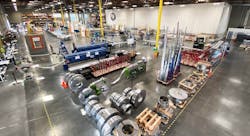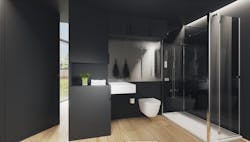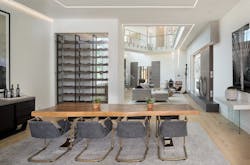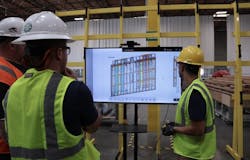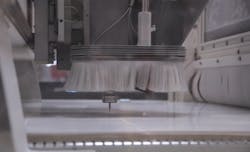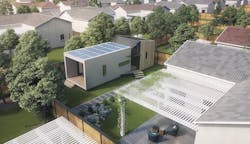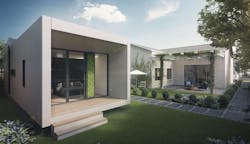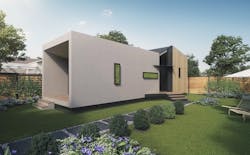Veev’s Amit Haller on Scaling Innovation and Shortening the Supply Chain
During the pandemic, while home builders were contending with extended lead times and a shortage of building materials and labor, off-site manufacturer Veev was completing a 78-unit emergency housing development in San Jose, Calif. Finished last October, the project took just 90 days to complete.
The off-site digital prefabricator and on-site installer of multi- and single-family homes and accessory dwelling units succeeded in shortening its supply chain and reducing selling prices while other companies were scrambling to find alternative vendors, making supply substitutions, and inserting escalation clauses in their sales contracts to cover rising lumber and other materials costs.
Veev, which originally launched in 2008 as Dragonfly Group, doesn’t use wood. The San Mateo, Calif., company frames walls using steel that is waterproofed and finished with high-performance materials. These fully closed and clad panels are trucked from Veev’s Union City factory complete with mechanicals, electrical, and plumbing systems and assembled on site by Veev’s five-member field team, which can install a wall every 30 minutes using simple snap-together connectors similar to train car couplings.
Last March, the company raised another $100 million to fund expansion into more production plants that design, manufacture, and assemble every component of its homes, including windows, doors, cabinets, and counters. Pro Builder talked with Veev’s co-founder and CEO Amit Haller about the company’s approach and vision for innovation in home building.
Pro Builder: Many innovative construction methods fail to be adopted because builders don’t see these alternatives as scalable. Is the Veev process scalable?
Amit Haller: Scalability is a huge hurdle because there are millions of people in the construction industry who continue doing things a certain way because that's just how they do it, and it’s been unchanged for the past 100 years.
The big challenge with the current industry is that houses are custom made; it's all craftsmanship. For example, every piece of tile requires someone to install it. Veev got radical and said forget the tile. There’s no tile. You might say, how do you do that? And I’ll ask, why do you need tile? The main reason is to create a waterproofing membrane in areas like the kitchen backsplash and in bathrooms because drywall should never be exposed to water.
RELATED
- Who Can Shorten the Supply Chain for Home Building?
- A Look at Lumber Prices From the Supply Side
- Industry's Skilled Labor Shortage Worse Than Pre-Pandemic
So, what if I could have walls with no water issues whatsoever? Suddenly, you don't need tile or drywall. I’m eliminating the problem. But you might say people really like tile for its style and architectural value. Great. So, what if through machines or by design I can just draw or texture walls that look like tile or create the right architectural values without tile?
By the way, we didn't invent this process. Car manufacturers and smartphone makers have been making their products available to consumers in any color for years. It’s called standardization or productization. We've done it in every single industry other than construction.
At Veev, we’ve standardized the production process but kept the unlimited ability to customize your home.
Look at the fashion industry ... You can get apparel in so many different colors and shapes, but in a massively scalable way versus just getting it from craftsmen or tailors. We need to do what the fashion industry has done. They started to look into standardization with sizes. You have extra small, small, medium, large, extra large, extra extra large, and so on, but at the end of the day, it's just eight or so sizes. That’s productization.
In the construction industry, there are a million different bathroom sizes. Why? Are people really using the bathroom so differently? There's a sink, toilet, shower, and maybe a bathtub. You can start to standardize, or productize, that room and its components.
One interesting thing that happens with scalability is that if I want to standardize something, I need to really understand the user. So I'm going to dive deep into the user’s life to understand how they use the sink. You might say, I wash my hands in the sink. But there's more: How much space do you need around the sink to place items? How many drawers in the vanity do you need? What size drawers? Where will you store different items within those drawers so you can better affect drawer size in order to make the right product for you?
PB: Doesn't standardization fly in the face of consumer choice regarding décor and finishes?
AH: It definitely does, but there’s a level of standardization and a level of customization. Consumers want to be able to paint, color, and texture the bathroom any way they want, but they couldn't care less about the standardization of the plumbing behind the wall. They just want the lifetime warranty that provides repairs in case something breaks or there’s a leak.
By standardizing what’s behind the wall, we’re creating the ability to focus on where we really bring value to the consumer, which is customizing the kitchen cabinets, the vanities, the flow of the layout, exterior cladding, and creating a smart home environment.
Standardization doesn't mean everyone gets the same car, all in black. What Henry Ford did was standardize the production line of cars so you don’t need to rethink and reinvent the transmission, the location of the engine, the starter, the wiring, and so on every time a car is assembled. The consumer wants the car to perform and be safe, but how that happens under the hood doesn’t matter to them. Home builders are reinventing the transmission, the engine, and so on every time they build a home from scratch. At Veev, we’ve standardized the production process but kept the unlimited ability to customize your home.
PB: What is the High-Performance Surface (HPS)?
AH: HPS is a “super” material [similar to Corian with a high-performance acrylic coating] that is more alluring, durable, and healthy than any traditional finish on the market and provides superior strength and quality to surfaces while generating a low-carbon footprint. In Veev homes, HPS is the material of choice for all interior walls, doors, vanities, built-in closets, kitchen cabinets, and countertops because of its thermoforming-enabled flexibility, customization options for printed colors and textures to resemble any desired finish, and compatibility with a wide range of lighting effects.
HPS is a jack of all trades—pleasing to the eye, certified hygienic and mold resistant, ultrasmooth to the touch, and possessing incredible strength. It also offers weather and UV protection, does not fade or degrade over time, resists stains, and does not absorb odors, making it equally versatile for combatting common sources of depreciation in and around the home.
Veev’s in-house supply chain and optimized panelized wall system utilizes HPS to significantly reduce the cost of installation when building homes. These savings are in turn passed on to the consumer in the form of lower up-front costs and long-term savings derived from the strength and quality of HPS.
RELATED
- The Framer Who Went Modular: Q+A With Nathan Young of ModsPDX
- Off-Site Construction: A Real-World Study: Putting stick-framing vs. panelized systems to the test
- More articles about on prefab and off-site construction
PB: How is Veev faring with supply chain constraints and rising building materials costs—steel in particular?
AH: Veev hasn’t been substantively affected by the rising cost of building materials and has actually been able to decrease its prices to developers during this surge in material prices. Our secret: We build with HPS and light-gauge steel, two simple but versatile materials that serve as an efficient alternative to the multitude of materials used in traditional construction.
Conventional builders typically use around 10,000 line items during home construction. Veev has reduced its line items to 500 for comparable projects. The multipurpose nature of HPS and light-gauge steel unlocks our ability to streamline our building process in this way, in addition to reducing construction waste and costs associated with transporting building materials. That’s because HPS and steel are more durable, lighter, and adaptable than materials like drywall and lumber, allowing us to tailor them to the precise requirements of our homes without compromising quality or generating excessive waste.
Our end-to-end home building approach has been key to our success despite continued supply chain constraints on building materials. We’ve retained control of each step of the building process and maintained an efficient prefabricated construction system for speedy design, development, and assembly of our homes.
PB: How much more inexpensive/quicker is a Veev project compared with a home or building that uses traditional construction methods?
AH: We’re building homes at up to four times the speed and at lower cost than traditional construction. For a recent example of how we’re eliminating inefficiencies in the home building process, look no further than our recent project for the City of San Jose. In a record 90 days, Veev completed a 78-unit development for city residents; a traditional project of this size usually takes months longer and incurs higher costs as a result.
Additionally, Veev’s innovative installation system enables just five team members to install one wall every 30 minutes, while the construction industry average runs days or weeks longer to accomplish the same task.
We have HPS instead of drywall, and that’s a big savings. While drywall is simple to install and requires easy craftsmanship, there are so many steps to finish it ... taping and mudding, and then you need to wait a couple weeks for the mud to dry, then you sand it, and if you’re going with a higher quality of finish, that requires more labor and time. Then there’s the finishing carpentry. The joke goes: Why do you need baseboards and trim around doors and windows? To hide the shame.
Drywall is cheap but in reality it’s really expensive.
We use a light-gauge steel instead of wood. And the way we use the steel is limited in terms of weight for a townhome project. We’ve also converted about 80% of the home’s wiring to low voltage instead of high voltage, so all of the switches and LED lights are IP [Internet protocol] based.
We only use high-voltage wiring where absolutely necessary—the outlets in all of the bedrooms and elsewhere, and the appliances. By doing that, we became far less sensitive to the cost of copper and wiring. And we use Category 6 cable, which is very thin and uses less copper than larger gauges. There's also an environmental benefit to that.
So, we’ve standardized a lot of things people don’t see, which allows us to better control our supply chain costs and also helps with the environmental aspects of what we do.
RELATED
- Why Do Builders Continue to Use Lumber?
- Material Issues Spark Interest in Building Innovations
- 3 Reasons Off-Site Construction Could Help Shape the Future of Housing
PB: How does Veev’s end-to-end home building process shorten your supply chain and avoid bottlenecks typical in home construction?
AH: Veev’s end-to-end approach solves for the misaligned incentives that have become endemic to traditional construction processes, especially as it relates to designing, developing, and building the home.
We deploy a highly automated process that helps us avoid slowdowns and inefficiencies characteristic of traditional building, in addition to reducing the amount of skilled labor—also currently experiencing shortages—necessary for building.
And while steel, along with other building materials, has seen its price increase during the past year, the effect hasn’t been as pronounced compared with lumber. Additionally, we require far less steel compared with waste-intensive materials like lumber because we can shape and modify it so we only use exactly what we need. For every square foot of new-home construction built using lumber, 4.5 pounds of waste is created. Lumber is also flammable and more susceptible to water damage, mold, and so on, adding to a list of inefficiencies endemic to the material.
Another way we’re avoiding home construction inefficiencies is through our proprietary design software, which automates up to 70% of building design across mechanical, engineering, and plumbing functions. By eliminating standard, repetitive tasks in the home design process, our teams can optimize their time and focus more attention on the design tasks that matter.
On the whole, Veev’s end-to-end control of the building process enables efficiencies of this nature, including the relatively low cost of the materials it builds with, all while creating high-quality homes with a consumer-first focus.
PB: How did you get your field crew synched so the assemblies can go up on site without hiccups once they arrive from the factory?
AH: At the start of every project, our field crew is made up exclusively of Veev employees because our system of building requires everyone involved in a project to understand and be able to execute on our unique process.
From there, we use a highly automated approach that reduces the need for outside labor. It’s a true “plug and play” system, wherein we clad single-sided wall panels and load them with digital home, MEP [mechanical, electrical, and plumbing] functionality at Veev’s production facility before being transferred to the construction site for speedy assembly.
This modular building approach, combined with the capabilities of our skilled team, allows us to arrive at a jobsite with much of the construction work having been done up-front. In turn, we’re able to complete projects much faster and with fewer workers while still producing some of the highest quality homes currently available.
PB: Why is Veev’s panelized system more flexible than other volumetric factory-built housing?
AH: The volumetric system is rigid, especially when it comes to design considerations. This rigidity in form and function works for certain kinds of projects, such as hotels, where builders are interested in quickly producing a high volume of cookie-cutter residences.
Single- and multi-family homes, however, demand a different level of variety and customizability. Our panelized system allows us to craft the home’s features and proportions to the desires of our customers, which is part of our customer-first vision. We’ve also pioneered a unique method of closing these panels at our fabrication facility—a key feature that sets us apart from other modular builders because it allows us to ship panels to the jobsite fully clad and thus instantly ready to be erected.
In many ways, it's similar to how Apple builds smartphones or Tesla builds cars. Just like those companies, we’ve standardized the “bones” of the product—the MEP functionality, built-in digital home technology, et cetera—while allowing for a highly customizable exterior bolstered by the wide ranging benefits of innovative materials like HPS.
PB: What will the recent $100 million funding enable Veev to do next?
AH: Our latest round of funding gives our team the capital needed to continue our expansion, bringing our innovative home building approach to communities affected by the national housing shortage. Currently, there is a shortage of 7 million homes across the nation, with a shortage of 3 million in California alone. Our vertically integrated approach can provide a blueprint for how to begin addressing this accessible housing crisis.
Our strategy is to build locally, meeting demand for new homes at a “micro” level and building fabrication facilities in the areas where we can serve the needs of the community, whether that’s for 300 homes or 1,000. We created a system that is copied exactly with a limited amount of capital, which mostly goes into the intellectual property, IT, and software.
The house is mostly designed in the virtual environment and then the plan goes to a simple off-the-shelf CNC machine. All four of our machines can handle those software files and build the homes. So the home could be anything you want. The team in the fab, they just build walls. It's exterior walls, interior walls. Sometimes they're larger, sometimes they're smaller, sometimes taller, a different color, different texture, but it's the same process again and again to reproduce those walls.
This funding unlocks our ability to build these “microfabs” to bring Veev homes to various demand areas around the Bay Area and, down the line, state and nationwide.
RELATED
- Katerra Wants to Disrupt the Construction Industry [VIDEO]
- Katerra Received $2 Billion in Funding—Why Did It Fail?
- Modular Builder VBC on the Verge of $25-Million Buy for Katerra Assets
PB: Because of Katerra’s recent demise, there inevitably will be comparisons drawn with other players vying to change the construction process. Why is Veev not a Katerra?
AH: We’re solving for a different problem than Katerra. Namely, when you look at what Katerra actually did, it becomes clear that they were not a modular construction company but a massive supply chain company. This reality allowed them to save on some material costs but did little to address the biggest problem of the construction industry, which is the major shortage of skilled labor available to work on site.
Further, many analysts have assessed Katerra’s model and concluded that they did “too much too fast.” On one level, I agree—they expanded rapidly around the world while neglecting to sufficiently invest in R&D and productization, which are both key to being able to efficiently build quality homes at scale.
Overall, though, I think Katerra actually did “too little too slow” and never created a truly integrated modular construction system. Because they expanded so rapidly before they had any kind of modular system in place that could match the size of the projects they were taking on, Katerra was slow to deliver its product and could never keep pace with what was being demanded of them.
At Veev, we’re taking the opposite approach: investing heavily in our system, our tech, and our people and focusing on meeting the need for housing at the local level. Whereas Katerra went thousands of miles wide but only a foot deep, we’re going miles deep even if it means only going a foot wide—which in California still translates to millions of homes!
Our “micro fab” facilities, once scaled, will empower us to achieve what Katerra could not: a robust, standardized system designed to meet the challenges of the housing shortage head on and eventually be scaled across the country.
More About Veev's ADU Design
Using the company's vertically integrated approach, the Veev accessory dwelling unit (ADU) features a modern design that includes home automation, appliances, furniture, and a sound system for the one-bedroom, one-bath unit, which also has a full kitchen. Pricing includes Veev's complete service offering, that is, the cost of the home (fully furnished and landscaped), labor, and site work, for an estimated cost of about $438 per square foot.
